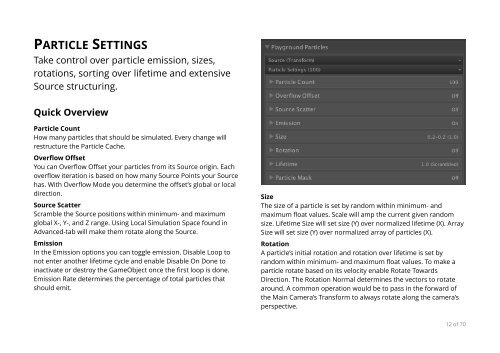Particle-Playground-3-Next-Manual
Particle-Playground-3-Next-Manual
Particle-Playground-3-Next-Manual
Create successful ePaper yourself
Turn your PDF publications into a flip-book with our unique Google optimized e-Paper software.
PARTICLE SETTINGS<br />
Take control over particle emission, sizes,<br />
rotations, sorting over lifetime and extensive<br />
Source structuring.<br />
Quick Overview<br />
<strong>Particle</strong> Count<br />
How many particles that should be simulated. Every change will<br />
restructure the <strong>Particle</strong> Cache.<br />
Overflow Offset<br />
You can Overflow Offset your particles from its Source origin. Each<br />
overflow iteration is based on how many Source Points your Source<br />
has. With Overflow Mode you determine the offset’s global or local<br />
direction.<br />
Source Scatter<br />
Scramble the Source positions within minimum- and maximum<br />
global X-, Y-, and Z range. Using Local Simulation Space found in<br />
Advanced-tab will make them rotate along the Source.<br />
Emission<br />
In the Emission options you can toggle emission. Disable Loop to<br />
not enter another lifetime cycle and enable Disable On Done to<br />
inactivate or destroy the GameObject once the first loop is done.<br />
Emission Rate determines the percentage of total particles that<br />
should emit.<br />
Size<br />
The size of a particle is set by random within minimum- and<br />
maximum float values. Scale will amp the current given random<br />
size. Lifetime Size will set size (Y) over normalized lifetime (X). Array<br />
Size will set size (Y) over normalized array of particles (X).<br />
Rotation<br />
A particle’s initial rotation and rotation over lifetime is set by<br />
random within minimum- and maximum float values. To make a<br />
particle rotate based on its velocity enable Rotate Towards<br />
Direction. The Rotation Normal determines the vectors to rotate<br />
around. A common operation would be to pass in the forward of<br />
the Main Camera’s Transform to always rotate along the camera’s<br />
perspective.<br />
12 of 70


